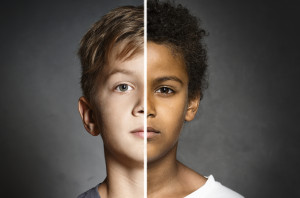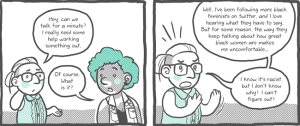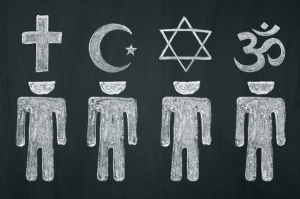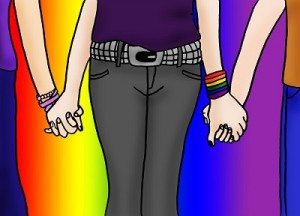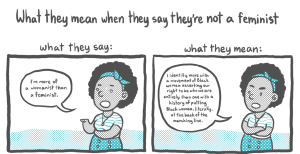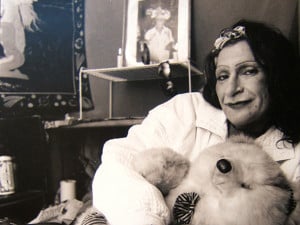
Source: Tagg Magazine
(Content warning: Child abuse, rape)
Have you ever come across a revolutionary hero’s story and felt yourself reflected in their personhood?
For instance, maybe this person was born in the same town as you. Or they shared identities with you, like being a woman, disabled, an artist, of color. Perhaps they shared an experience that has informed the way you move through the world.
Most of the feminist heroes I was taught about in school were narrowed in one focus. For example, I learned Susan B. Anthony fought for women’s suffrage and Rosa Parks sat in defiance of segregation.
Both of these women were depicted as feminists dedicated to one cause. However, Rosa Parks wasn’t solely fighting against one form of oppression – racism – she was also fighting against sexism.
The layers of a person’s identity are important in their movement work, which is why it’s crucial to amplify the narratives of those who live at the intersections of race, gender, disability, and so on.
This is why knowing people who lived intersectional experiences – like Sylvia Rivera did as a mixed race Venezuelan-Puerto Rican trans woman, sex worker, and trauma survivor – is imperative for feminists to honor those who fought tirelessly for social change.
The way I felt when I discovered Sylvia Rivera’s story was like I had found my mother.
My life mirrored Sylvia’s in the way that one’s face and mannerisms mirror their parents’. I couldn’t believe someone documented Sylvia’s gender fluidity, traumas, and sex work experiences, which helped me deal with my own feelings of isolation around these taboos.
Currently, Sylvia Rivera is gaining more visibility by being mentioned in LGBTQIA+ speeches, usually by fellow trans people. But the limitations on a sound byte rarely give her the due respect she deserves for fighting on multiple fronts for liberation.
We can see from this video, which was unearthed by Reina Gossett in a lesbian’s archive in New York City, Sylvia spoke fiercely against police brutality, gay assimilation, incarceration, homelessness, and rape.
https://vimeo.com/45479858
It’s been forty long years of resistance and brilliance to liberate queer and trans people from violence, and the work is ongoing. It’s important to know this history and the legacies that have paved the way for today’s continued liberation work.
Thankfully, Sylvia Rivera’s involvement in the Stonewall Riots has been documented in Martin Duberman’s book, Stonewall. Most of the facts listed here are pulled from Stonewall and her Randy Wicker documentary interview, also shared from Reina Gosset, available on Vimeo.
Without further ado, here are five facts about Sylvia Rivera:
1. Sylvia Rivera Had a Trans Girlfriend, Julia Murray
Often times, trans women’s fluid and queer sexuality is erased.
This is largely due to outdated medical practices that established many of the cisnormative requirements for being “legitimately transgender,” such as hating your genitals, playing with toys of the “opposite” gender since childhood, and being heterosexual in your true gender.
Sylvia, however, didn’t fit neatly into any of those categories.
During her youth, she was proudly and unapologetically gay when confronted by authoritative figures – primarily police, judges, and medical professionals. She would often have biting comments in response to their harassment, and this is one of my favorite things I love about her.
Sylvia and Julia met while they were organizing with other transgender people that lived in the all-transgender house in Brooklyn, the Transie House. She recalls getting arrested for helping out people and organizing political movements in response to anti-LGBTQIA+ violence, such as Matthew Shepard’s murder.
Shortly before moving into the Transie House, Julia had a mental health crisis. Sylvia says this is something many trans people went through. Since the Transie House housed trans people in need, it was a perfect place for Julia to be.
Julia did not like to sleep alone, so she opted to sleep on the rug in the living room where Sylvia stayed. Sylvia offered her bed to Julia and they grew closer as friends over the months. Around February 1999, they became lovers.
Sylvia shares,
I feel that both of us being transgendered, we understand what the other has gone through. We have always been with men, but the men that we have met in our lives haven’t been able to give us the sensitivity that we share between ourselves.”
In the Randy Wicker interview, Sylvia’s friends also recall how Sylvia’s relationship with Julia helped Sylvia become sober from a lifelong addiction to alcohol and drugs.
This narrative of trans women loving and supporting each other through addiction, homelessness, and mental health crisis is crucial to combat these cisnormative narratives of what trans people have been (and should be) like.
And also, I love that their relationship was a transformative healing force in a time of revolution and historical change.
(Source: The New York Times Magazine, June 27th, 1999)
2. She Engaged in Commercial Sex to Fund Her Community’s Survival
According to the Pay It No Mind documentary and Duberman’s Stonewall book, Sylvia Rivera approached Marsha P. Johnson to begin the organization Street Transvestite Action Revolutionaries (STAR). She wanted to begin it with finding a home for trans people that was off the streets.
Sylvia and Marsha found an abandoned trailer truck and housed nearly two dozen homeless trans women. They both engaged in survival sex work to pay for groceries, and asked that if other people were working the streets they should pay a percentage to fund the STAR House.
One morning, Sylvia and Marsha were returning with groceries when the trailer was driven away. Fortunately, all the trans women (with the exception of one) were able to get out before the driver took them away.
With this absence of a home, Bubbles Rose Marie, a STAR member, asked a mafia leader to rent an empty building. With his approval, the STAR House was moved to 213 E. 2nd Street in New York City.
The building had no plumbing, electricity, or heat. Sylvia, along with a few fellow STAR members, took to fixing the building themselves not knowing anything about repairs. They were successful!
The STAR House was in constant need of money, and gay organizations at the time were ambivalent in their promises of support. It usually fell upon STAR members, Sylvia and Marsha especially, to hustle harder in commercial sex to fund their expenses.
One day, Sylvia ran into the landlord who demanded $900 in backpay for three months of missing rent. When Sylvia confronted Bubbles about this debt, she admitted she hadn’t been paying the landlord. The landlord called the authorities and evicted everyone from the STAR House.
But they didn’t leave without throwing the refrigerator out the window as a final “fuck you.”
3. Sylvia Survived a Traumatic Childhood
When Sylvia was three years old, her mother poured two glasses of milk mixed with rat poison. After drinking an entire glass, her mother urged Sylvia to drink the other as well.
A few sips into the milk, Sylvia refused to drink anymore because of the bad taste. Her mother poured sugar into the milk and urged Sylvia to drink again. After Sylvia gagged on the taste, her mother took the glass and drank it herself. Then her mother hid in the bathroom for a few minutes before crying and running out of the apartment to the neighbor’s.
In the hospital, Sylvia had her stomach pumped and recovered well. Her mother, unfortunately, died two days later.
Sylvia was taken under the care of her grandmother, Viejita. When Sylvia was seven years old, she was sent off to a Catholic home for boys because Viejita fell ill. When she recovered, she resisted taking Sylvia back, but the nuns’ strong recommendation made her reconsider.
From that point forward, Sylvia was shuffled between different caretakers. One of them, Viejita’s Colombian friend named Elisa that she sponsored for immigration, took care of Sylvia for a while.
Elisa was kind to Sylvia when she completed her numerous chores, but every so often, Elisa would beat Sylvia for little-to-no reason. When Sylvia was ten years old, Elisa attempted to sexually assault her and then beat Sylvia for not consenting.
By ten years old, Sylvia had sex with her fourteen-year-old cousin (it is unclear if it was consensual or assault), and she was also frequently being molested by a married man who lived down the block from Viejita. It was at this age that neighbors and Viejita began to suspect Sylvia was gay.
In 1962, when Sylvia was eleven years old, she ran away to 42nd Street in New York City, which was known to be the area that gay people congregated.
Like many young trans girls, Sylvia was sex trafficked and met Gary, a boy she fell in love with. They stayed together for seven years doing drugs and engaging in survival sex trade on 42nd Street.
During this time, Sylvia became well-acquainted with fellow queens (what we might now call trans women), including Marsha P. Johnson. It was also during this time that Sylvia came into her name, Sylvia Lee Rivera, which was celebrated with a christening ceremony of fifty friends, most of whom were Latinx and Black.
Remembering the christening, Sylvia said, “It was just like being reborn. […] You knew you were going into a different life. And I remember the preacher saying when he put the water on my head, ‘Don’t forget: This is going to be a hard life.’”
(Source: Stonewall, pgs. 20-24, 65-67)
4. She Refused to Take Hormone Replacement Therapy
From Duberman’s Stonewall,
Initially, Sylvia liked what Dr. Stern’s hormones did to her body, reducing facial hair and making her more curvaceous. But she soon decided to stop the injections. ‘I came to the conclusion,’ she later recalled, ‘that I don’t want to be a woman. I just want to be me. I want to be Sylvia Rivera.’”
She continues on to say that she likes to “dress up and pretend” and further explains, “I don’t want to be a woman. Why? That means I can’t fuck nobody up the ass. Two holes? No, no, no. That ain’t going to get it.”
This may be confusing, as gender itself is confusing, especially in the changing political and personal context over the course of history. Sylvia hated the term “drag queen,” but was still involved and partook in the drag culture. She also identified as a transvestite, and later on as transgender – which is why modern day LGBTQIA+ movements now call her a transgender woman.
However, we can see from her statement that this is complicated by her not wanting to be a woman. In my own early gender questioning, I also knew I didn’t want to be a woman.
I didn’t think there was another gender possibility that affirmed my femmeness, respected my body, and didn’t label me as male.
To me, trans womanhood was a loaded identity that assumed I wanted surgeries, hormones, and to be read as cisgender.
For a while, I identified as genderqueer. But after having experienced being “too femme” for employment and dating, and how I felt increasingly upset by the labeling of my body as male by medical professionals, I began to identify more with a trans woman’s experience than most other gender identities.
I believe that Sylvia felt similarly. We both actively resist(ed) cisnormative narratives by loving our bodies and claiming transness despite not fitting into the dominant transgender mold.
In my experience organizing trans femmes and trans women, it’s fairly common for people assigned male at birth to identify as non-binary before identifying as a trans woman.
Myself included, we can hold both of these identities (non-binary and trans woman) as true to ourselves, because no singular definition can truly hold the complexity and power of not adhering to white supremacy’s colonial gender binary system.
5. Her Favorite Pokémon was Pikachu
And her girlfriend Julia bought her a plushy Pikachu as a gift.
This last fact may seem odd, but I feel it’s important to share the little details of our heroes’ lives that humanize them. The issue with historicizing revolutionaries is that they become flattened as idols or martyrs riddled with trauma who died for a cause.
Their humanity is lost between the struggles of their time and the tireless efforts they put into creating liberation.
This creates the current conditions for activists and revolutionaries who are alive right now and fighting for liberation to be dehumanized through idolization as well. Our heroes are seen as not needing love, attention, support, and resources because somehow they will make due on their own.
This is why living legends, like Miss Major, are crowd fundraising to pay their retirement after a long life of changing history.
It’s important to know our histories and legacies, to know the people who created the freedoms we enjoy today. It’s equally important to celebrate and support our current leaders, not just the ones who are “respectable,” but the ones our movements have pushed out of the spotlight in order for our political messages to be “easily digestible.”
Radical liberation has come from those with the least to lose and the most to fight for. Let’s make sure we honor them as past, present, and future beloved ancestors.
(Quick and huge acknowledgement to Reina Gossett for making this history available in a public and free manner. Reina writes about her archival work being stolen without respect to the violence she endured to make it accessible to girls like me, and people like you.)
[do_widget id=’text-101′]
Luna Merbruja is a Contributing Writer for Everyday Feminism. She’s the author of Trauma Queen, an intern at Biyuti Publishing, international sorceress of performance art, and co-coordinator of the 2014 International Trans Women of Color Network Gathering. She’s currently working towards her career as a sex and trauma therapist.
Search our 3000+ articles!
Read our articles about:
Our online racial justice training
Used by hundreds of universities, non-profits, and businesses.
Click to learn more









